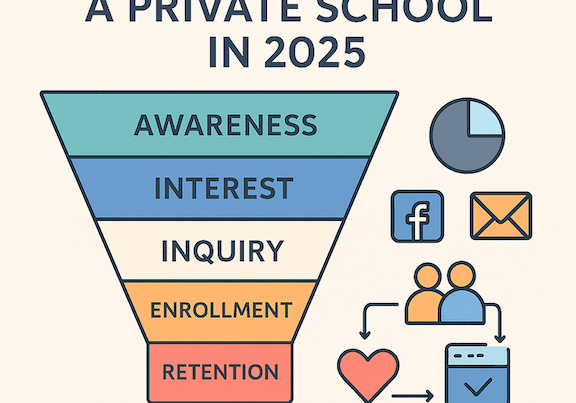
Similarly, schools are beginning to take notice of the paradigm shift in the way students and families are looking for new schools. To meet the potential new students where they are, organic seo for schools is an approach being embraced by many to ensure schools reach their target audience online.
In addition to organic SEO as a tremendous opportunity to increase applications, raise enrollment, elevate brand awareness and more, some academic institutions have embraced PPC for schools to reach prospective families for a number of reasons.
It’s important to recognize that organic seo prominence has not stifled the success of paid advertising. Smallbizgenius reports that brand awareness can be improved by 80% just by using Google’s advertising services. When an institution is betting on meeting new goals for enrollment, paid advertising cannot be ignored.
Wondering how to utilize PPC campaigns to increase enrollment at your school? Read this guide to PPC strategies for school marketing.
What is PPC?
“PPC” stands for pay-per-click advertising. As the name suggests, PPC advertisements only cost money when someone clicks on them. While it’s easy to shy away from paid advertising due to expenses, PPC means paying for the success you experience.
For example, running advertisements in a publication or on TV usually means paying to run the ad for a certain length of time, regardless of the number of views it receives. While television and publications may be effective channels for reaching new audiences, running a TV or newspaper ad does not ensure the right audience is reached or engaged. Such traditional approaches to digital marketing are becoming increasingly outdated with the emergence of organic SEO and PPC for schools
Benefits of PPC advertisements include the ability marketers have to define the audience and affordability in comparison to other forms of paid advertising. If a marketer chooses to run PPC advertisements, services such as Google allow them to define your target audience and choose how much you would like to pay.
In return, Google will help estimate the length of time the ad should run to reach the level of engagement desired. Once the PPC advertisement is set up, monitor its progress according to the number of people who have engaged with the ad and how much money is owed.
Fortunately, PPC is fairly accessible to businesses and only requires a moderate amount of knowledge to begin. When looking to optimize your budget, however, becoming an expert on PPC is best.
Why is PPC Important for Schools?
Combining organic and paid tactics in a marketing plan can help a school grow and reach enrollment goals. While organic tactics create an impressive foundation for a school’s online presence, PPC will help extend an institution’s reach. As a result, the school will pull in prospective families who otherwise would not have found the institution.
PPC is a wonderful choice for institutions that desire tight control on their advertising budget. Choosing when to improve organic reach and when to start a PPC ad will help closely monitor costs and stay within budget without forfeiting the benefits of paid ads. To manage this budget, research on the cost of each method compared to its likely results is essential.
SEO and PPC Working Together
Ramping up SEO campaigns for schools is a great first step to understanding PPC ads. PPC services like Google Adwords use similar concepts to SEO methods. In addition, following SEO best practices means impressing visitors with your website and extending the reach of the brand, further improving the conversions achieved through your PPC ads.
Keywords are a crucial part of SEO. They act as buzzwords that prospective families will likely type in to search for schools like your own. Utilizing these keywords in SEO will help your school’s website show up in search results, and targeting your PPC ads with those keywords will give your institution an extra boost.
For instance, Google Adwords allows marketers to pay for products, websites, and services to show up in the top search results for chosen keywords. Marketers must bid on the keywords for which they’d like to be the top search results. PPC is ranked higher than SEO, so if you have competitors that are successful with SEO methods for certain keywords, consider ranking higher than them with PPC ads.
Keep in mind that certain keywords come at a higher expense than others. Doing research about which keywords will target the school’s niche and calculating if they are worth the investment is key to a successful campaign.
While choosing keywords, also remember that students are often the first online searchers for new schools. Target and impress prospective students first so that they show what they’ve found to their parents.
Using Branded Ads
Our intentions for our PPC ads are to drive traffic to our own websites and drive our own conversions. Poorly created ads, however, can inspire a desire in our target audience for the general product or service without making the conversion. As a result, these ads could end up driving conversions for a competitor.
Branded ads are an important part of the strategy due to their tendency to build a connection between the brand and the target audience. When prospective families search for schools, they need to be convinced not only that the school provides education, but that the school provides exactly the type of education they’re looking for. This distinction will set you apart from your competitors.
An unethical, yet not illegal, tactic is to use someone else’s brand name within PPC ads. In doing this, your competitors could be stealing your traffic. There are many different types of fake brand ads and fraud of which you should be aware and from which you should stay proactive in protecting your brand.
Estimating PPC Costs and Value
Deciding if running PPC ads is the right choice depends on understanding how to calculate the costs of using a PPC service. Before the campaign begins, it’s important to set key performance indicators (KPIs) and compare them to the results so that you can learn from your mistakes and refine your future campaigns.
At first, it will be difficult to estimate PPC costs without a history of data to reference. The first few campaigns will be experimental, and comparing their results to the KPIs will help you improve their performance through retargeting and altering copy or visuals. By evaluating and altering your PPC ads, you’ll be able to increase their value.
Some KPIs to consider are the number of clicks, number of impressions, click-through rate, conversions, and return on investment. First, set your desired result for these factors and then compare them to your actual results once the campaign is finished. Evaluating your results will help you understand the success of your PPC ads and budget for future campaigns.
Determining the Cost Per Lead
Determine the expense regarding the cost per click with this simple formula: divide the total amount spent on PPC campaigns by the number of clicks on the ads. In other words, if an ad generated 200 clicks on a $200 campaign, the school paid a dollar for each click.
In this scenario, the school paid $200 to generate 200 new leads. For comparison, the average cost per click (CPC) is $2.14. Monitor this expense to budget for future campaigns with the goal to reduce the cost per click.
Regarding the number of impressions, calculations will be similar to the number of clicks. For this KPI, however, measure the number of people who have viewed the ad for the price paid. Impressions are typically measured in thousands, as higher numbers of people will view the ad rather than click on it.
Further, determining the click-through rate is essential for measuring the effectiveness of the school’s PPC ads. To calculate the click-through rate, divide the number of clicks by the number of impressions. Then, multiply that result by 100 to find the percentage of people who clicked on the ad after they viewed it.
Determining the Return on Investment
Budgeting for PPC ads means estimating the cost of views and clicks, but it’s arguably of higher importance to understand PPC ads’ return on investment. Running ads that lose money without gaining enough conversions are not worth running.
First, identify which action the school needs the ad viewer to take when viewing the ad. In the case of school marketing, PPC ads should direct viewers to the school website or other landing page that targets enrollment. Find the conversion rate of the ad by dividing the number of conversions (likely students interested in enrollment) by the number of clicks.
Second, think differently about the value of PPC ads by calculating the return on investment. To do this, subtract the revenue generated from new enrollees by the cost of the campaign, then multiply this result by 100 to find a percentage.
On a side note, it’s important to keep in mind that the effectiveness of the ad is not the only reason for conversions. Receiving a high number of clicks but a low conversion rate means the problem might lie with an ineffective marketing funnel. In the case of schools, a marketing funnel should be a page that effectively convinces visitors to click on information and forms for enrollment and sign up for further communication with the school.
Forge Ahead With PPC for Schools
Embarking on a school marketing paid advertising campaign requires having the knowledge and tools to effectively utilize PPC for schools. If you’re looking for further help, it can be difficult to find agencies that understand and properly utilize PPC, likely due to their focus on web design.
VujaDay is a digital marketing agency that specializes in school marketing and has a wealth of experience with PPC campaigns. To strengthen your marketing efforts, contact us today.



